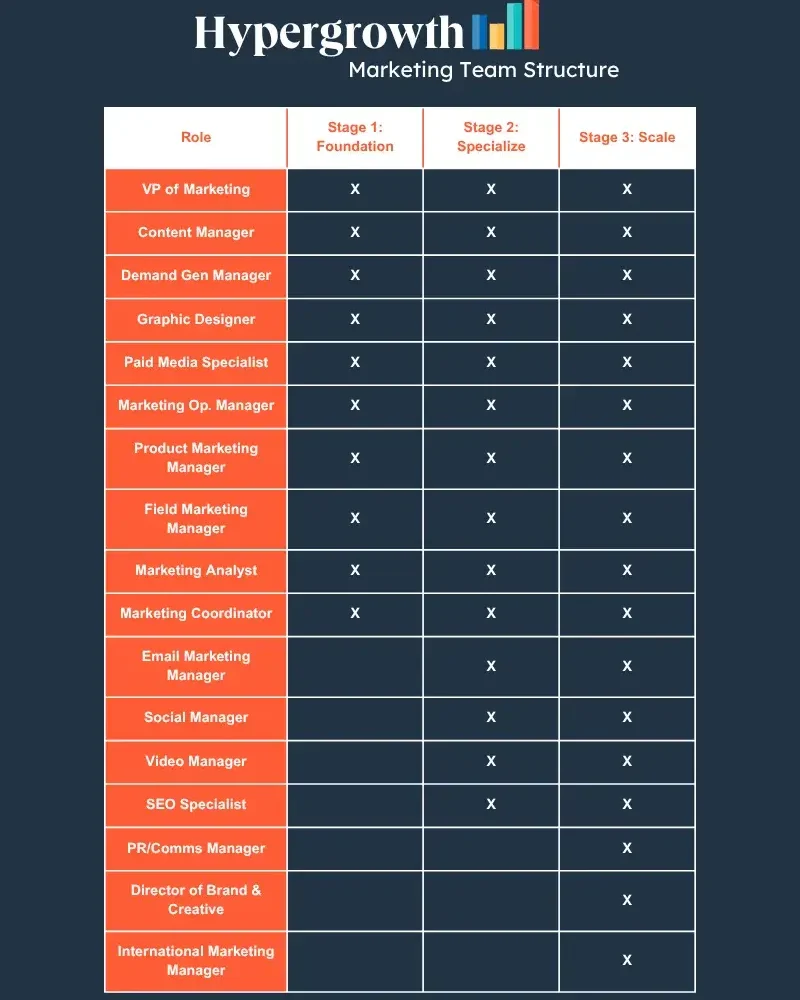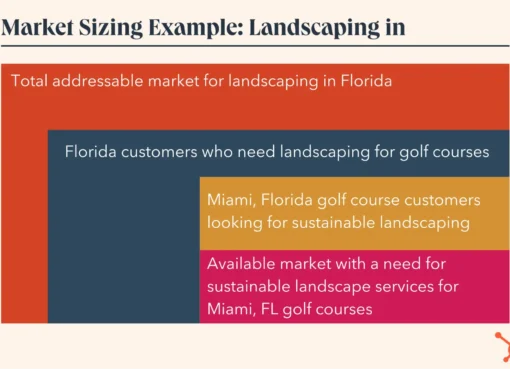In times of chaos, marketing team structure is often overlooked, but for companies in hypergrowth, this can be a recipe for disaster.
![→ Download Now: The Illustrated Guide to Org Charts [Free Guide + Templates]](https://no-cache.hubspot.com/cta/default/53/7cbd0328-6c8c-40e0-98dd-c3b6e6be96f0.png)
The lean marketing team that got a business off the ground is not the same team that will help it scale. Trust — as a serial marketing team of one, I’ve experienced the fallout firsthand.
Failing to evolve your marketing team during hypergrowth can lead to overwhelm, poor quality work, and missed goals, but how exactly do you structure it for growth?
The template shared in this article will help you scale from five to 25 people without losing speed, clarity, or impact. Each scaling phase is triggered by revenue milestones and comes with hiring priorities, role evolution, and structure recommendations.
Table of Contents
- Why Structure Matters in Hypergrowth
- Marketing Hiring Plan Template
- How to Prioritize Roles
- FAQs about Scaling a Marketing Team in Hypergrowth
Why Structure Matters in Hypergrowth
At hypergrowth speeds — where companies double yearly and headcount scales rapidly — the right marketing team structure is crucial to preserving momentum.
A recent McKinsey survey found that nearly 67% of organizations report being overly complex and inefficient. In other words, poor roles and structure have led to slower decisions, redundancy, and reduced velocity.
But why is that? In my experience, much of it comes back to workload and productivity. More ambitious goals often mean bigger and a higher volume of tasks to tackle. Your labor and roles need to reflect these goals.
For example, if you want to increase your content output, you need more content creators and strategists. If you’re launching a product, you’ll need a product marketing manager to do it right.
Piling more work on team members with already full plates will only lead to burnout and even employee churn. (Again, I’ve seen this firsthand.)
Co-founder of Stage 2 Capital and former HubSpotter Mark Roberge echoes this, saying:
“We have a long conversation with our founders out of the gate about their five-year scale plan and do a bottom-up analysis to understand the realistic inputs…That‘s a critical strategic decision that determines everything — how many reps you’ll hire, how many support people, how many engineers, how much property.”
Talent is a resource, and if you don’t get the resources needed to get a job done, don’t be surprised if it doesn’t happen.
Marketing Hiring Plan Template
According to Stripe, hypergrowth teams typically restructure every 6–9 months to stay aligned with business growth.
Elad Gil, an entrepreneur, operating executive, and investor/advisor to the company, supports this idea, saying organizations can sustain 3x growth as team complexity increases by implementing the right organizational design.
That said, a marketing organization that’s scaling up will need a new, hypergrowth-friendly team structure. The template below walks through three phases on the journey to a team of 25:
- Foundation
- Specialization
- Scale
We’ll discuss what marketing roles you need at each phase, associated metrics, when you should hire specialists, and overall outline an effective marketing organization structure for rapid growth. The best hiring sequence will ultimately vary from company to company, but these suggestions are a great place to start.

Phase 1: Foundation (5–10 People)

As a company reaches $5–15M in annual recurring revenue (ARR) and acquires over 100 customers, the first phase of team building begins.
This stage is all about establishing the core marketing functions and setting up foundational tools and processes. A big part of this is hiring generalists with wide skill sets who can wear different hats if needed.
Learn more about the skills all marketers should have in our article, “20 Technical Skills Every Marketer Needs.”
While the priority of some roles will depend on the nature of your product and business, others are universal. The actual job titles may change, but here are the roles I’d recommend at this phase:
VP or Director of Marketing
This role leads strategy, manages early hires, and aligns the team with business goals. They also tend to be the marketing decision-maker and the one held accountable for hitting metrics.
Efficiency metrics: Return on marketing investment (ROMI), Customer Acquisition Cost (CAC), marketing-sourced pipeline, Marketing Efficiency Ratio (MER)
Content Marketing Manager
They own content creation and SEO. They may create a variety of content themselves (i.e., blog articles, emails, landing pages, videos) or manage the production by others.
Efficiency metrics: Publishing frequency, organic traffic growth, content-attributed MQLs, first-30-day page traffic
Resources:
- Free Content Marketing Certification Course: Grow Better with Content
Demand Generation Manager
This role oversees acquisition and pipeline generation. They’re focused on getting conversions and leads to sales.
Efficiency metrics: MQLs, SQLs, cost per acquisition (CPA), marketing-sourced pipeline, payback period
Graphic Designer
They create visual content, including website materials, social media, and premium content, among other things.
Efficiency metrics: Campaign consistency rate, turnaround time per asset, engagement uplift (CTR, social shares), brand adherence audits
Paid Media Specialist
They manage advertising and paid social.
Efficiency metrics: Impressions, CTR, CPC, CPA, ROAS (return on ad spend)
Resources:
- “10 Essential PPC Courses for Every Marketer”
- How to Build Pay-per-Click Marketing Campaigns [+ Best PPC Platforms, Tools, and Software]
(Optional) Marketing Operations Manager
They manage automation and reporting systems. This would include working with tools like HubSpot.
Efficiency metrics: Marketing Efficiency Ratio (MER), campaign setup time, funnel conversion rates, data accuracy score
(Optional) Product Marketing Manager
They focus on messaging and positioning.
Efficiency metrics: Sales enablement usage, win rate uplift, sales cycle reduction, product-qualified leads
Resources:
- How to Do Product Marketing Like A Pro: Strategy, Tips, & Examples
- Free Download: Ultimate Product Marketing Kit
- What Is a Product Marketing Manager? Job Description and Salary
(Optional) Event or Field Marketing Manager
They support in-person events, which may be especially helpful for B2B organizations.
Efficiency metrics: Leads generated per event, CPL, event attendance rate, pipeline sourced from events
Resources:
- Event Marketing: How to Build Your Strategy & Connect With Customers in Real Life
(Optional) Marketing Analyst
They monitor, measure, and report on performance.
Efficiency metrics: Dashboard refresh cadence, attribution model coverage, forecast accuracy, data insights generated
(Optional) Marketing Coordinator
They assist with a variety of executional needs.
Efficiency metrics: Task completion rate, campaign support accuracy, coordination turnaround time
During this phase, your marketing team structure is best if it remains flat, with all team members reporting directly to the marketing leader. With fewer people on the team, this hierarchy helps avoid confusion in decision-making and aids in collaboration.
Pro tip: Gil recommends leaders initially “allocate functional areas based in part on who has the time and skill set to focus on and make that area succeed.” This doesn’t mean they’re stuck in that area forever. “Remember, nothing needs to be permanent,” Gil continued.
At my last employer, I saw one teammate jump from web development to account management, marketing, sales, then back to web over a decade — and I’m sure there are other departments I’m missing. It gave me whiplash to watch, but I see why it happened.
For new and smaller businesses, phase one is just about getting a running start. Leaders need reliable people they know can set things up for success and prove the concept before investing fully.
That’s also why the people filling your phase one roles should be generalists. As marketing generalists, each team member will be able to quickly adapt to shifting priorities and help build traction across core channels.
Need a graphic in a crunch, but your designer is busy with your website? The demand gen manager has time to help. Generalists are agile, and agility is key when scaling in hypergrowth.
Tools needed: CRM system like HubSpot, email marketing software to manage contacts and nurture leads, and CMS to publish content online or manage your website. Role-specific tools like the Adobe Suite or Canva.
HubSpot can also help you automate tasks and track your efficiency metrics.
Daniel Foulkes Leon, Senior Marketing Operations Manager at CoachHub, a HR tech company based in Germany, explains how HubSpot helped his team scale during hypergrowth and secure $330 million in financing.

Source
“In twelve months, [our team had] grown from 250 to around 1,000 employees,” says Daniel. “We needed to find some quite elaborate ways to prioritize the work and automation….HubSpot gives us tools that we don’t use in separate universes, but rather together. And everyone benefits from that.”
Expected impact: Establish a functioning funnel, create foundational processes, and generate early pipeline traction.
Can’t I use AI to fill these marketing roles?
AI can help support some of these roles, of course, but it isn’t foolproof. At every phase, you need humans refining and reviewing anything sourced from artificial intelligence, especially generated content.
What about remote talent?
In my experience, it’s smart to opt for local or in-office team members when you’re just starting to build your marketing team and strategy.
Remote work comes with its own set of challenges, like navigating time zone differences, feeling disconnected, and maintaining productivity. Don’t make this phase even more complicated than it already is. Keep things in-office until they’re less in flux.
Phase 2: Specialization (11–17 People)

Once a company surpasses $15M ARR and serves over 500 customers, it enters a new market with larger competitors. This means marketing must become more sophisticated and often complex to attract attention.
With this in mind, phase two introduces specialization and a layer of management. Specialization usually takes place based on department or channel ownership to improve performance tracking, enable focus, and support repeatable growth.
New potential roles may include:
Director of Demand Generation
This role oversees both paid and inbound efforts focused on driving conversions and sales. They’ll also likely manage the demand generation manager.
Efficiency metrics: Leads generated, task completion rate, campaign support accuracy, coordination turnaround time
SEO Specialist
Your content manager handled SEO in phase one, but as you grow, you need more advanced knowledge and skills to see improved visibility and site performance in search engines. That’s where this hire comes in.
Efficiency metrics: Task completion rate, campaign support accuracy, coordination turnaround time, and organic traffic.
Email Marketing Manager
This is another responsibility that grows out of the content marketing manager’s responsibilities. It’s focused on lead nurturing and communications via lifecycle campaigns and retention.
Efficiency metrics: Number of email campaigns launched, email open/conversion rate, campaign support accuracy, coordination turnaround time
Resources:
- Free Email Marketing Certification
Social Media Manager
Social media is a must these days and, as we’ve learned as an industry, it’s a full-time job. This role will manage your brand’s presence and engagement on various platforms.
Efficiency metrics: Task completion rate, campaign support accuracy, coordination turnaround time
Videographer or Video Marketing Manager
Video is a non-negotiable in today’s world, mainly thanks to social media. Phase 2 is a smart time to invest in talent that can help you build and scale this strategy.
Efficiency metrics: Number of videos completed, campaign support accuracy, coordination turnaround time
From here, additional content writers may also be needed to help scale content output, or a campaign manager coordinates cross-channel initiatives tied to revenue. It depends on your strategy, goals, and bandwidth.
Also, at this point, you are in a better position to explore a remote or hybrid structure. You may even start considering international team members. With your foundation built and solid, you likely have the processes, tools, and documentation needed to support team members in different locations while maintaining consistency.
Organizationally, the team should begin forming functional teams with clear leaders who act as middle managers. Channel-specific ownership improves focus (e.g., content, search, and demand), and the analytics function should stand alone for objectivity and rigor.
Tools needed: More advanced marketing automation platform (like HubSpot Pro), attribution, and tracking tools.
Expected impact: Drive reliable, scalable performance across every channel and introduce efficient campaign processes.
Phase 3: Scale (18–25 People)

At the final stage — triggered when the company reaches $40–100M ARR and 1,000+ customers — structure your marketing team to support global operations and long-term scale.
That means introducing a fully layered marketing organization with both strategic and executional roles across functions and regions.
New role considerations include:
Director of Product Marketing
This role owns and guides the vision for go-to-market strategy and enablement. They also manage the product team.
Efficiency metrics: Task completion rate, campaign support accuracy, coordination turnaround time
Director of Brand or Creative
This role leads brand storytelling and visual identity. They also likely manage any graphic designers.
Efficiency metrics: Task completion rate, campaign support accuracy, coordination turnaround time
Account-based Marketing (ABM) Manager
This role focuses on marketing to key segments or even specific accounts. It dances the line of sales and marketing and can enable sales and marketing alignment.
Efficiency metrics: Task completion rate, campaign support accuracy, coordination turnaround time
Resources:
- 8 steps to build your account-based marketing strategy [+ recommended tools]
- Free Account Planning Template
Conversion Rate Optimization (CRO) Manager
This role works on improving on-site and funnel conversion rates.
Efficiency metrics: Conversion rate, task completion rate
Marketing Automation Specialist
This role supports backend workflows and integrations. This could be related to operations, service, or even web and marketing.
Efficiency metrics: Workflows launched, Task completion rate
Customer Marketing Manager
This role drives engagement and retention. They are focused on keeping customers happy and loyal.
Efficiency metrics: Task completion rate, campaign support accuracy, coordination turnaround time
PR/Communications Manager
As you become a global name, how the media and public perceive you in general becomes increasingly important. This role will oversee media relations and external messaging to help you create the best image.
Efficiency metrics: Task completion rate, campaign support accuracy, coordination turnaround time
International Marketing Lead
Speaking of going global, this role will focus on managing localization and regional expansion.
Efficiency metrics: Task completion rate, campaign support accuracy, coordination turnaround time
At this stage, the structure should include at least two layers of leadership, with directors managing managers and clearly defined functional areas like brand, demand generation, product marketing, and operations.
Tooled needed: Advanced analytics platforms and ABM solutions like 6sense or Demandbase.
Expected impact: An enterprise-ready team that drives both pipeline and brand awareness across markets. The team must also align on both global strategy and localized execution.
How to Prioritize Roles
In the perfect world, you’d love to hire all these folks, right? Unfortunately, the business world is not that rosy (especially right now).
Use these five points to help you decide what marketing roles to prioritize:
- Evaluate the revenue impact potential of the role and whether it ties directly to growth targets.
- Identify skill gaps within your existing team and hire to complement existing capabilities.
- Assess underperforming channels that require new expertise or leadership.
- Consider where the team is stretched operationally and needs support.
- Align with long-term strategic initiatives such as expansion, branding, or product shifts.
FAQs about Scaling a Marketing Team in Hypergrowth
What’s the ideal leader-to-individual contributor ratio?
Start with a ratio of one leader to five or six individual contributors (aka, in phase one). As complexity increases, Directors or Team Leads should manage smaller groups of three to seven. Don’t overload a manager. Keep these guidelines in mind:
- Managers should typically oversee 4 to 7 direct reports.
- Directors should manage 3 to 5 team members or leads.
- The VP of Marketing should supervise between 4 and 6 direct reports for strategic alignment.
How do I prevent silos?
You can prevent silos by introducing a management layer before teams grow too large. Cross-functional meetings and shared metrics tied to revenue rather than function also help maintain alignment.
When do I hire marketing specialists?
Avoid hiring too many specialists before you’ve validated core channels.
Specialist roles should be introduced in phase two when your team size is 11–13 and ARR is about $15–20M. This is typically when your business needs dedicated focus per channel and deeper expertise. It’s also when you’ll likely have the processes, tools, and resources in place to start refining.
Should I hire full-time employees or contractors?
You can use contractors for executional or temporary needs, such as design or video. However, you should prioritize full-time hires for strategic or core functions like demand generation or product marketing. Don’t prioritize creative hires without a strong strategic plan in place.
Build to scale, not just to survive.
The reality is: your marketing org is either your growth engine or your biggest bottleneck. Structure it to scale — because in hypergrowth, guesswork costs too much.
Ready to future-proof your team? Use this framework, revisit it often, and adjust as your strategy evolves. Growth waits for no one — but with the right plan, your marketing team won’t just keep up. It’ll lead the charge.
















Comment here